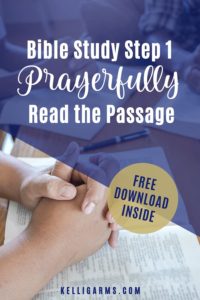
by Kelli Garms | Aug 5, 2022 | Bible Study
Updated. This Bible study post to help you apply the passage was originally published on May 26, 2020.
Now that we have looked at the tools for Bible study, prayerfully read the passage, worked through the passage using the Bible study worksheet, cross-referenced the verses, and researched the passage, it is time to apply the passage.
Often, we jump to apply a passage too quickly or we do it in a selfish way rather than a God-honoring way. When we seek to apply the passage, we should not ask the question, “what can I get out of this passage?” or “how does this passage help me?” Instead, we should ask “how should my understanding of this passage change my life, thoughts, and actions from now on?”
Read through your notes
Read through all of the notes you’ve taken so far. This includes any journaling you did at the beginning. It also includes the answers to the questions on the worksheet and the notes you took from your research. Don’t forget about the cross-references you chose for each verse.
As you read through the notes, ask yourself how the information should change you. It might be a behavior that needs to change. It could be a belief you’ve held that this passage disproves. It could be that the passage reinforces something you’ve known all along. Maybe God has a promise for the believer or a generally true statement.
Your answer may match what you wrote on the application section of the worksheet, or it might be a completely different Truth you find. This doesn’t have to be some grand revelation you have never heard before. In fact, in most cases, I find it is something I know to do but am not doing.
“So whoever knows the right thing to do and fails to do it, for him it is sin.”
James 4:17
This is the most important step. If we take all the other steps but fail to apply the passage, the exercise has been pointless. We will have accumulated knowledge but not made it useful.
We can take this a step further by writing down when or with whom we plan to practice this application. This isn’t always possible as it depends on the type of action the passage asks us to take, but sometimes it helps to keep us accountable to what the Word is teaching us to do.
Tasks
- Read through the notes you’ve taken for Proverbs 3:5-8 and write down the application.
- If you can, write down when or with whom you plan to take this action.
If you would rather download this entire Bible study process in the free workbook, you can enter your information below, and it will be delivered directly to your email.
[activecampaign form=13]
Continue the Bible Study Series

by Kelli Garms | Jul 29, 2022 | Bible Study
Updated: This Bible study post to help you research the passage was originally published on May 22, 2020.
Now that we have talked about the tools, prayerfully reading the passage, working through the passage using the Bible study worksheet, and cross-referencing the verses, it is time for step 4: research the passage. This step might take you several days. It depends on the length of the passage you are studying and the number of resources available on those verses.
The Setup
When I start this step, I want to make sure I keep all of the notes from each verse together in one place. I write the number corresponding to each verse down the left margin of my page, leaving enough room in between to take notes for each verse from several sources.
I add any cross-referenced verses I want to include next to the verse number (see Step 3: Cross-Reference the Passage). Even though you have already cross-referenced the verses, when you walk through this step, you may find more verses to add to your list.
Study Bible Notes
Once my note page is ready to go, I research the passage by looking at the notes in my study Bibles. If you don’t have a study Bible, don’t worry, there are plenty of resources available to you. I jot down anything I think adds to my understanding of the verses, including those things I understood myself in the previous work.
Feel free to take this step as deep as you want to take it. Many times, I will come across a concept referenced in the notes that leads me on a trail of discovery through other passages of Scripture. It can be a fun ride! These are things you should journal and come back to.
Apps and Online Resources
Once I have exhausted the notes in the study Bibles, I turn to some apps and online resources. I have accumulated several apps over this journey, but I started with the Blue Letter Bible app. This resource has a learning curve, so I will point out a place to start.
Once you have opened the Blue Letter Bible app and have found the passage, tap on a verse number and select “text commentaries.” On a side note, notice the study tools available in the top part of that menu. You can come back to those and learn how to use them.
Find a commentary that you can understand, and start reading what it says about your passage. Take notes as you read, keeping your notes organized by verse. When I research the passage, I always look for a commentary by David Guzik. He is easy to understand, and he includes notes from many of the other commentators in his commentary of the passages.
Repeat this step as many times as you want with as many commentaries as you’d like.
A Word of Caution
You need to do the steps of Bible study in order. Once you have spent personal time with the passage, asking the Holy Spirit to guide you in your study, and you have worked through the passage on your own and with cross-references, only then are you in a position to see what others say about the passage.
You will not agree with everything you read as you will find that many of the commentators contradict each other. Remember that the Word of God is inspired, but the notes of men are not. Yes, they have a lot of training and education, but on occasion, I have found a lone voice with whom I agreed about a passage.
Just because it is the popular belief does not mean it is the correct one.
And now, your page of notes should be a mess! Remember when I told you not to buy a fancy notebook? You’re welcome! Unfortunately, I learned this the hard way.
I urge you NOT to stop on this step. Although this series is set up for you to be able to start at step 1 and only go as far as you want to go, you have now reached a point where you should go to the next step: Apply the passage. You’ve done all of the hard work, and now it is time to implement.
Tasks
Using our passage of Proverbs 3:5-8, start your research. Don’t feel like you have to study every source at your disposal. Just pick a study Bible and a commentary with which to begin.
If you would rather download this entire Bible study process in the free workbook, you can enter your information below, and it will be delivered directly to your email.
[activecampaign form=13]
Continue the Bible Study Series

by Kelli Garms | Jul 22, 2022 | Bible Study
Updated: This Bible study post to help you cross-reference the passage was originally published on May 20, 2020.
We’ve talked about the tools you need for Bible study, prayerfully reading the passage, and working through the verses. Now it’s time for step 3: cross-reference the passage.
Why Cross-Reference the Passage?
Depending on the number of verses you find, this step can take a couple of minutes, or it can take a long time. But this is an incredibly important step because the best way to make sure you are interpreting a passage correctly is to allow Scripture to interpret Scripture.
Cross-references are those tiny verses written in the margin or the center column of your Bible. Sometimes they are at the bottom of the page, too. If your Bible doesn’t have cross-references, you can use an app to find them. Blue Letter Bible is a great free resource that contains cross-references, and we will use it in future steps of the process, too.
How I Do It
Your process doesn’t have to look like mine, so if you find a way that works better for you, do it. I write down the cross-references in my notebook (remember the one we talked about in the introduction to the series?). This way, I don’t have to keep my finger on the page in my study Bible.
Once I’ve copied them all down, I start looking them up. By this point, I’m pretty  familiar with the passage I’m studying, so I look for verses that help clarify or give examples pertaining to the passage. When I find a verse I want to connect to the passage, I circle it in my notebook. As I come across verses that don’t really help or are specific to words I don’t need clarified, I cross them out. I will take this further in future steps.
familiar with the passage I’m studying, so I look for verses that help clarify or give examples pertaining to the passage. When I find a verse I want to connect to the passage, I circle it in my notebook. As I come across verses that don’t really help or are specific to words I don’t need clarified, I cross them out. I will take this further in future steps.
This step can seem unproductive at times, but other times, when you cross-reference the passage, you come across incredible nuggets that shine a whole new light on things. Remember, you can’t go wrong when you allow Scripture to interpret Scripture.
If you have come this far, you are well on your way to becoming a Bible scholar. If this is as far as you want to go, that’s ok. This series is designed so you start at step 1 and only go as far as your current season allows.
Tasks
Follow these steps with our passage, Proverbs 3:5-8.
If you would rather download this entire Bible study process in the free workbook, you can enter your information below, and it will be delivered directly to your email.
[activecampaign form=13]
Continue the Bible Study Series

by Kelli Garms | Jul 15, 2022 | Bible Study
Updated. This Bible study post was originally published on May 15, 2020.
So far, we have talked about the intro: tools you need for Bible study and step 1: prayerfully reading the passage. If you missed those posts, no worries; just click the links to read them.
Now that you have read the passage multiple times and in different translations, it’s time to start asking some questions. A helpful tool for this step is the worksheet in my free Bible study workbook. If you haven’t already downloaded it, click on the link and get your copy ready.
One of the questions I am asked most often is which passages of Scripture to study. I discuss this in-depth in the worksheet companion video series. For now, we will continue studying Proverbs 3:5-8.
Author and Audience
Do a little research, and I mean a little, to find out who wrote the passage you are studying and to whom he wrote it. We are the audience now, but when the author penned the words, he meant it for a specific audience, and this information might be vital for correct interpretation of the passage.
We should always read the Bible the way the author intended it to be understood and not through our own filter or cultural lens. Knowing who wrote it, why he wrote it, and to whom he wrote it will help us get the interpretation right.
If you have a study Bible, you can usually find this information in the notes at the beginning of the book. If you don’t have a study Bible, you should be able to find out easily online, using sources like Biblegateway.com or the Blue Letter Bible app. Sometimes, the first few lines of the book will tell you, too.
Type of Literature
Another thing to keep in mind is the type of literature this passage represents. Is it history, prophecy, poetry, etc.?
 For example, Proverbs is “wisdom literature.” This means it communicates principles that are generally true but not necessarily universally true. So the content of Proverbs should not be mistaken for promises. It is made up of general “if, then” statements, not specific promises from God to His people.
For example, Proverbs is “wisdom literature.” This means it communicates principles that are generally true but not necessarily universally true. So the content of Proverbs should not be mistaken for promises. It is made up of general “if, then” statements, not specific promises from God to His people.
Don’t go down a rabbit hole with this one, just make a note of it. This information should be readily available in the same resources listed above.
Why Should You Paraphrase?
Now it is time to write the passage in your own words. This doesn’t have to be fancy or “churchy.” Just write down what the passage says in your normal, everyday words.
This step helps you think through and clarify the passage. Some passages have become so familiar to us or the language is so different from ours that we glaze over them without truly understanding them. Writing them in our own words forces us to process what the passage actually says.
Don’t be afraid to get this wrong. This is a beginning step, so it is ok to change your mind as you learn more about the verses throughout your study. If you struggle with this, I encourage you to watch the worksheet companion video series. I talk through some of the mental blocks this step creates.
Questions to Ask
The hardest part is done! (Sort of.) Now we just need to ask and answer some questions about the verses to deepen our understanding:
- What do these verses teach me about God and His character?
Remember that the Bible is a book about God, so we read it to get to know Him, not ourselves. You will learn about yourself through your study, but it will be in light of Who God is. It takes the focus off of how the passage makes you feel and the filter you put on the verses.
This may seem a little out there, but I promise it will click if you stick with it. If you find that you can’t get past this question, watch the worksheet companion video series for some direction.
- What should I learn from these verses?
Look for specific call-outs in the passage: a promise, a sin, a command, a principle, etc.
This puts action behind your study. If we become simply consumers of the Word, but we don’t put it into action, the book of James says we are deceiving ourselves (1:22), and we won’t be blessed (1:25). This question is where the Holy Spirit convicts.
“So whoever knows the right thing to do and fails to do it, for him it is sin” (James 4:17).
And that is it for step 2! It may have been a lot for you to process, and that is ok. Stay on this step as long as you need to. You may decide this is as far as you want to go. This is a great way to work through an entire book of the Bible, and it is a good exercise to do along with your daily Bible reading.
Tasks
Using Proverbs 3:5-8 as the passage, work through these steps. You can use the free Bible study workbook or simply use a blank piece of paper or journal.
If you would rather download this entire Bible study process in the free workbook, you can enter your information below, and it will be delivered directly to your email.
[activecampaign form=13]
Continue the Bible Study Series

by Kelli Garms | Jul 8, 2022 | Bible Study
Updated. This Bible study post was originally published on May 13, 2020.
In the last post, we walked through the introduction to this series by discussing the basic tools you need for Bible study. If you missed that post, you can read it here. Now let’s get started with the steps to study Scripture for ourselves.
Bible Study Step 1: Prayerfully Read the Passage
This step may seem pretty simple, but remember, the goal is to really know the passage at the end of this process, so prayerfully reading the passage needs to be intentional. Let’s break this down a bit.
Pray
Before you begin to study, you need to pray. You need to ask the Holy Spirit to partner with you. This means praying that He will keep the distractions at bay (the enemy will throw everything at you because he wants to make you ineffective), help you see things you haven’t seen before, and show you how the passage should change you.
This step requires you to put yourself in an environment conducive to learning. This will look different for each individual. For you, it might be music playing in the background before the kids get up, sitting in your special chair with a cup of coffee. It could look like reading on your phone in the middle of the night while you’re rocking a baby to sleep. Maybe it will be sitting on the park bench listening to the passage in one ear while you keep the other ear attuned to the kids playing on the playground. The point is, be open and receptive to what the Holy Spirit wants to teach you, and place yourself in a position and environment that is conducive to accomplishing that goal.
Read
When you read the passage, focus on the words used. If there is a word you don’t know, look it up or write it down for future research. Read the passage in several different translations. You can find apps with different translations and that also allow you to listen while you read along or do your chores.
Another great way to pore over the passage is to write it out with your own hand. Use that notebook we discussed in the last post. Choose one of the translations and copy the text. There is a strong connection created in your brain when you physically write something out.
Journal

And then take a minute to journal your thoughts. Did the reading bring up any questions? Did anything strike you as odd or impressive? Did you learn something new? This journaling doesn’t have to be long and involved, just jot down your first impressions as a place to begin.
If you have never done Bible study on your own or if this is a particularly busy season in your life, this may be as far as you want to go with the process. It is the most important step because the Word of God is living and active. Just spending intentional time in the Word will change your life.
Tasks:
Walk through this process using Proverbs 3:5-8. The first two verses might seem familiar to you, but you might be surprised how many nuggets we gloss over when the passage is well-known.
If you would rather download the process in a FREE workbook, you can enter your information below, and it will be delivered directly to your email.
[activecampaign form=13]
Continue the Bible Study Series

by Kelli Garms | Jul 1, 2022 | Bible Study
Updated. This Bible study post was originally published on May 6, 2020.
What tools do you really need to study the Bible? Honestly, you really only need a Bible and the Holy Spirit. If you don’t have a Bible, you can’t study it, and if you don’t have the Holy Spirit, you won’t understand it.
But beyond that, there are a few essentials you need if you want to really dive into the passage. As we move through this series, I will add the tools you need for each step. I know you want to know them all now, but you may decide to only work through step 3, so you won’t need the tools for step 4. To begin, though, let’s talk about the basics.
Which Bible Translation Should You Use?
This is a very personal decision. Bible translations are not the same as Bible paraphrases. There is a continuum of Bibles ranging from word-for-word translations to thought-for-thought paraphrases. It isn’t an issue of which is better, but it is an issue of understanding what you are using.

A word-for-word translation attempts to get as close as possible to the original language. A thought-for-thought paraphrase interprets the original language and writes it in a way that might be more familiar to you. It is up to you to decide if you want a Bible that might require a little more work to understand versus one in which someone else tells you what the passage means.
Which Bible Type Should You Use?
Should you get a study Bible? Should you get a journaling Bible? Should you get a large-print Bible? It depends on the outcome you want and what works best for you.

Study Bibles have great notes and cross-references. They tend to be bigger and heavier, and they can also be a bit more expensive. Unless you like hardcopy Bibles, you might prefer to access a lot of the notes online.
If your goal is to write in your Bible and take extensive notes, you should choose a Bible that has wide margins or a lot of white space on the page. And if you are a little nervous about writing in your Bible, getting a journaling Bible specifically for this exercise might be just the ticket you need to give yourself permission to mark up the pages.
Since I know you will ask, I have an ESV Study Bible I use for the notes and the cross-references. I have an ESV Single Column Journaling Bible I purchased when I started this study method. I also reference several other Bibles including the Study Bible for Women HCSB version, the CSB She Reads Truth Bible, the KJV Scoffield Bible, and the Reina Valera Spanish translation (yes, I have accumulated quite the collection of Bibles over the past 40 years).
Should You Get a Fancy Journal?
No, don’t go buy a fancy notebook. One of the biggest roadblocks to diligent Bible study is being afraid to ruin a beautiful notebook with your scribblings. And you will scribble. The goal isn’t to write the next great Bible commentary, but to have a place to jot down your thoughts, prayers, reactions, and research. Start with a notebook in which you are not afraid to write.
Make sure you choose a paper notebook and not an app on your phone or a document on your computer. There is something that happens in the brain when you physically connect pen to paper. As you watch your hand write the words, they become part of you. Since the end result you desire is to grow closer to God by studying His Word, it makes sense that you make the words part of yourself.
Which Pen Is Best?
Do not put too much importance on the pen. I have used a cheap Bic pen, Sharpie pens, PaperMate Ink Joy pens, erasable pens, and they all have their pros and cons. For this first step, while you’re still taking notes, the pen doesn’t matter. When you get to step 6 where you will write in your Bible, we will revisit this question.
This series is designed so you can stop the overwhelm of Bible study. You can end the study of a passage at any step in this process. Always start with step 1, but go only as far as you want to go. If you would rather download the process in a FREE workbook, you can enter your information below, and it will be delivered directly to your email.
[activecampaign form=13]
Continue the Bible Study Series






 familiar with the passage I’m studying, so I look for verses that help clarify or give examples pertaining to the passage. When I find a verse I want to connect to the passage, I circle it in my notebook. As I come across verses that don’t really help or are specific to words I don’t need clarified, I cross them out. I will take this further in future steps.
familiar with the passage I’m studying, so I look for verses that help clarify or give examples pertaining to the passage. When I find a verse I want to connect to the passage, I circle it in my notebook. As I come across verses that don’t really help or are specific to words I don’t need clarified, I cross them out. I will take this further in future steps.
 For example, Proverbs is “wisdom literature.” This means it communicates principles that are generally true but not necessarily universally true. So the content of Proverbs should not be mistaken for promises. It is made up of general “if, then” statements, not specific promises from God to His people.
For example, Proverbs is “wisdom literature.” This means it communicates principles that are generally true but not necessarily universally true. So the content of Proverbs should not be mistaken for promises. It is made up of general “if, then” statements, not specific promises from God to His people.



